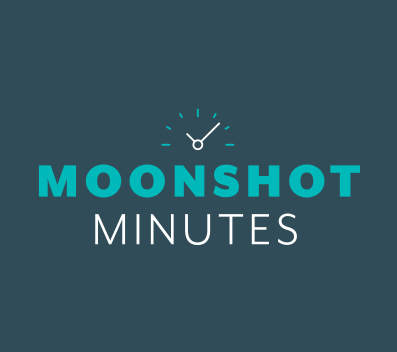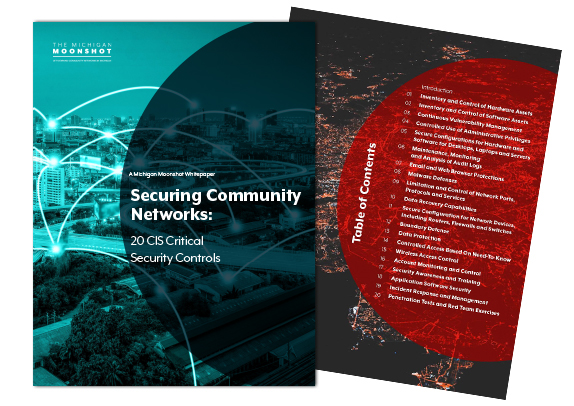The provision of supportive educational resources is vital to the success of the Michigan Moonshot. Merit has developed the following resources to assist you throughout your broadband journey. Additional resources from like-minded organizations have also been compiled below.

MICHIGAN MOONSHOT BROADBAND FRAMEWORK
This crowdsourced framework will serve as a community network primer and the basis for planning your community’s roadmap. Contained within, you’ll find overviews on policy and technology, community success stories, links to myriad resources and planning tools from national broadband leaders, and a detailed plan for building a regional network.

MICHIGAN MOONSHOT BROADBAND FRAMEWORK APPENDIX
Visit the Michigan Moonshot Broadband Framework Appendix for links to RFP evaluation templates for feasibility studies, consulting, engineering, construction, ISP operators and more. In addition, a robust legal template library featuring resolutions for bond proposals, notices of public hearings, franchise agreement and more are located on the site.


MICHIGAN MOONSHOT DIGITAL INCLUSION RESOURCES
In order to support our members seeking to expand digital inclusion within their own communities, Merit and the Michigan Moonshot partnered with the National Digital Inclusion Alliance (NDIA) to generate an extensive list of available resources.


SECURING COMMUNITY NETWORKS FRAMEWORK
Malicious network database attacks at the local government and community level are becoming ever more common, potentially harming cities and towns on an unprecedented level. As an operator of a community network, you are no stranger to how important broadband and network access is to your communities and constituents. You help underserved residents and propel them through the 21st century. With Merit’s tailored community network security framework, we outline guidance for your entire community and all of its connected devices-to safely operate and thrive while being connected to a worldwide audience.
Becoming Broadband-Ready Toolkit
By: Next Century Cities
This online toolkit was developed with input from Next Century Cities’ member communities, featuring best practices and strategies from a diverse array of successful broadband deployment projects nationwide. It is a resource for local leaders in the planning phase of a community network that includes recommendations for identifying goals, prioritizing digital inclusion, choosing success metrics, and more.
https://nextcenturycities.org/becoming-broadband-ready/
Broadband for America’s Future: A Vision for the 2020s
By: Benton Institute for Broadband & Society
High-Performance Broadband in the next decade can be a vital engine for economic growth—a tool to deliver individual opportunity and strengthen communities. Author Jonathan Sallet, Benton Senior Fellow and former General Counsel of the Federal Communications Commission, presents a comprehensive policy framework for the 2020s to ensure that affordable, competitive, High-Performance Broadband reaches everyone in the U.S. The framework addresses deployment, competition, affordability and adoption, and the special role of community anchor institutions.
Community Connectivity Toolkit
By: Community Broadband Networks Initiative of the Institute for Local Self-Reliance
This online resource provides case studies, advice for approaching incumbent providers, broadband service maps, podcast and video resources, FAQs and more.
https://muninetworks.org/content/community-connectivity-toolkit
Digital Inclusion and Meaningful Broadband Adoption Initiatives
By: Benton Institute
This report presents findings from a national study of eight digital inclusion organizations across the United States that help low-income individuals and families adopt high-speed internet service. The study articulates that there are four digital inclusion activities considered necessary for helping low-income individuals and families adopt broadband in ways that were most appropriate to their personal needs and contexts. The four digital inclusion activities are: providing low-cost broadband; connecting digital-literacy training with relevant content and services; making low-cost computers available; and operating public access computing centers.
https://www.benton.org/sites/default/files/broadbandinclusion.pdf
Federal Communications Law Compliance Overview for 2020
By: Baller Stokes & Lide
This document summarizes the main federal regulatory requirements that apply to providers of cable television, telecommunications, interconnected voice over Internet protocol (VoIP), Internet access, and other communications and information services.
ILSR Community Broadband Map
Communities invest in telecommunications networks for a variety of reasons – economic development, improving access to education and health care, price stabilization, etc. They range from massive networks offering a gig to hundreds of thousands in Tennessee to small towns connecting a few local businesses.
This map tracks the various ways in which local governments have invested in wired telecommunications networks. Additionally, it addresses state laws that discourage such approaches.
www.muninetworks.org/communitymap
Michigan Broadband Cooperative Community Broadband Framework
By: Michigan Broadband Cooperative
This framework was developed to quantify the broadband landscape in Michigan’s Prosperity Region 9 (Hillsdale, Jackson, Lenawee, Livingston, Monroe, and Washtenaw counties) and to provide a framework by which these and surrounding communities could begin to close the broadband gap. This framework was funded through a grant from the Greater Ann Arbor Area Prosperity Initiative, with significant contributions from the University of Michigan Ginsberg Center, Poverty Solutions Center and the Foster Swift law firm.
Michigan Broadband Roadmap
By: 21st Century Infrastructure Commission
The Michigan Consortium of Advanced Networks was created to develop a broadband road map for the state, the purpose of which is to identify gaps in service coverage and capacity, current efforts underway to address connectivity problems, and strategies and recommendations for the public and private sector to pursue over the coming years to achieve ubiquitous connectivity.
https://connectednation.org/wp-content/uploads/sites/13/2019/01/Final-Roadmap-8-8-18.pdf
Michigan Community Broadband Playbook
By: Connected Nation
This playbook has been designed to help communities develop a local environment and culture to enhance and support the expanded access, adoption and use of high-speed internet and related technologies. The playbook is designed to challenge your community to develop effective technology leadership and advocacy and to ask questions of your community that will enable an accurate assessment of current needs and, ultimately, better planning, execution and expansion of broadband technology.
http://connectmycommunity.org/playbook/
Michigan Department of Environment, Great Lakes and Energy District Office Contact List
Michigan has a rich ecosystem and a robust process for protecting that ecosystem. It may be necessary to obtain a permit from the Michigan Department of Environment, Great Lakes and Energy to cross wetlands, streams, rivers or other bodies of water. It is recommended that you contact your local district office to discuss your project and review any permit requirements. A permit to cross streams and wetlands can take 60-90 days to receive.
https://www.michigan.gov/documents/deq/wrd-permit-staff_402908_7.pdf
Pew State Broadband Policy Explorer
The Pew Charitable Trusts’ state broadband policy explorer lets you learn how states are expanding access to broadband through laws. Categories in the tool include broadband programs, competition and regulation, definitions, funding and financing, and infrastructure access.
Planning a Community Broadband Roadmap: A Toolkit for Local and Tribal Governments
By: National Telecommunications and Information Administration
This toolkit provides advice on developing a community broadband road map for building broadband networks, enhancing public computer centers, expanding broadband to unserved areas, encouraging public-private partnerships and promoting broadband connectivity to homes, businesses and institutions.
This advice will help public officials, planners, citizen groups and other stakeholders make their broadband project—however grand or small—the best it can be.
https://www.ntia.doc.gov/files/planning-community-broadband-roadmap-apr2016.pdf
The Poynter Institute & Crash Course
COMMUNITY ANCHOR INSTITUTIONS: Are you searching for media literacy and digital inclusion resources for your community? Check out these two informational YouTube video series created by the Poynter Institute and Crash Course!
Media Literacy
Navigating Digital Information
Rural Utility Service Forms 515 and 515a
Construction costs for a fiber-optic network of any significant size will quickly reach the millions of dollars. Multiple ways exist to approach construction RFPs, but one expedient method is to use the Rural Utility Service Forms 515 and 515a. This is a standard contract and specification used to provide a contracting mechanism for direct buried infrastructure.
https://www.rd.usda.gov/resources/forms
Sample Documents for Public Private Partnerships
By: The Coalition for Local Internet Choice
CLIC’s P3 Documents Library is a compilation of relevant documents submitted by a range of organizations. Documents are intended to add to the body of knowledge about broadband public-private partnerships. These include general resources and guides on topics such as funding, management, partnerships, network maintenance, sample agreements and court documents.
http://www.localnetchoice.org/ sample-documents-for-p3s/
The Emerging World of Broadband Public–Private Partnerships
A Business Strategy and Legal Guide
By: Coalition for Local Internet Choice and Benton Institute
Public-private partnerships can take many forms depending on multiple factors – parties should work through the options and select the one that works best for them. The first section of this guide focuses on the business considerations that can make public-private partnerships work well – or not so well – for all concerned. The second section starts with issues surrounding a public entity’s legal authority to enter into a broadband public-private partnership and on the procedural requirements that the entity may have to meet to act on that authority. The section then goes on to analyze the major legal issues that typically arise in a broadband public-private partnership project, from early planning through the negotiating stage. The legal portion of the paper is written with a public sector audience in mind, but the general legal principles are relevant for any party considering participating in a broadband public-private partnership.
https://www.benton.org/sites/default/files/partnerships.pdf
The Quilt Map of United States Regional Education Networks
Through the Quilt, non-profit regional research and education networks collaborate to develop, deploy and operate advanced cyberinfrastructure that enables innovation in research and education.
https://www.thequilt.net/about-us/the-quilt-participants/
The United States of Broadband Map
The United States of Broadband map attempts to fill the gap in understanding between the FCC’s data and the actual speeds experienced by Americans, based on billions of speed tests conducted through M-Lab’s platform. Almost 900,000 people run M-Lab tests every day in the United States alone. The USBB map shows data both collected through the M-Lab platform and collected by the FCC through Form 477. You can compare the datasets by census tract, county, ZIP code and state House and Senate districts by zooming in and out.
https://www.newamerica.org/oti/reports/united-states-broadband-map/
Why Broadband Matters
Broadband Connects America has developed an extensive set of factsheets which help demonstrate why broadband matters. These resources include information on the importance of broadband in areas including healthcare, small business, postsecondary education and more. View the full list of factsheets below.